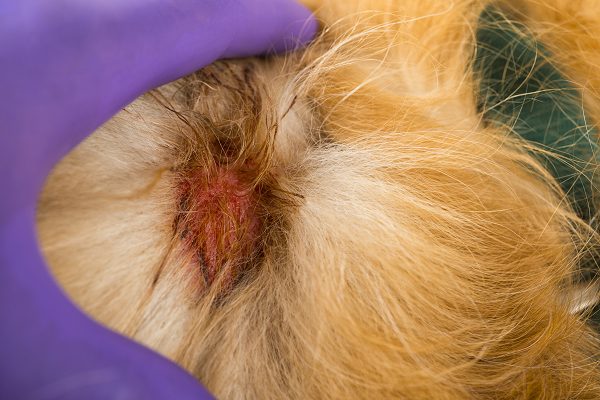What is a hot spot?
Hot spots – also known as pyotraumatic dermatitis or acute moist dermatitis – are red, inflamed skin lesions that appear quickly, ooze, and may contain pus. Hot spots can be found anywhere on a dog’s body, but the most common sites are the head, legs, and hips. These painful, itchy, smelly sores may be very obvious or may be hidden beneath matted fur.

What causes hot spots?
Hot spots are usually caused by self-trauma when a pet scratches an itch so vigorously that it creates an open wound. Many things can cause the initial itch in dogs including:
• Allergies. This could be food allergies or inhalant allergies that cause itching.
• Reactions to insect bites. This could be from fleas, mites (Sarcoptes, Cheyletiella), or other small insects (e.g., caterpillars, bees, wasps, lice, gnats, or mosquitoes).
• Ear infections. Bacteria or yeast in the ear canal can be so irritating that the dog scratches at his ear, creating hot spots on the ear flap, behind the ear, or on the neck.
• Pyoderma. Primary skin infections also caused by bacteria or yeast may incite the dog to scratch an area so much that a secondary hot spot forms.
• Poor grooming. Dogs with unkempt hair coats bite at tangles, creating open wounds. Matted fur prevents air from reaching the skin and retains water after a dog swims or gets caught in the rain so the skin stays wet. This sets up a perfect environment for a hot spot.
• Boredom. Dogs, like people, develop bad habits. Instead of biting their fingernails, bored dogs lick areas that are easily accessible. When they lie down, the feet and forearms are right under their faces so hot spots often occur there.
• Orthopedic problems. Pets with arthritis or back problems tend to lie down much of the time. Lying on one side creates abrasions over pressure points, like hips or hocks (ankles), where bony protrusions have little muscular padding, especially in elderly dogs with diminishing muscle mass. When the pet licks the abrasion, a hot spot erupts. Pets also lick or chew at degenerating joints much like people rub a sore knee to relieve the pain, creating hot spots in the process.
• Anal gland inflammation. Infected or impacted anal glands are painful and annoying. Dogs lick the area around the rectum and can cause hot spots under or on top of the tail.
“Hot spots can dramatically increase in size in a very short period of time.”
When a pet licks the sore spot, it irritates superficial nerve endings in the skin which stimulates more itching followed by more licking, biting, and scratching. This lick-itch-lick cycle is the basis for the self-trauma that causes hot spots. Hot spots can dramatically increase in size in a very short period of time. Pet owners may go to work after noticing a pinpoint area of redness and come home at the end of the day to find a raw lesion the size of a pancake.
How are hot spots treated?
The goal in treating a hot spot is to stop the trauma and prevent the development of a deep skin infection, so the first step in treating hot spots is to stop the self-mutilation. Some options to prevent your dog from doing this include:
• placing an Elizabethan collar (also known as an E-collar or cone) on your pet that stops the pet from chewing at the hot spot
• covering the hot spot with a sock or bandage to act as a barrier
• topical or oral steroids and antihistamines to reduce the itching. (Consult your veterinarian before using any medications intended for humans as they are often toxic to pets.)
It often takes a combination of all options to stop the trauma. In the meantime, the underlying cause of the hot spot must be addressed:
• If the hot spot formed as a result of impacted anal glands, they will need to be expressed.
• If the cause is a flea allergy, a flea control preventative should be taken monthly (or as directed) to control the entire flea life cycle.
• If arthritis is the culprit, your veterinarian may prescribe non-steroidal anti-inflammatory drugs (NSAIDs) such as meloxicam (Metacam®), carprofen (Rimadyl®, Vetprofen®), deracoxib (Deramaxx®), or other pain medications such as gabapentin (Neurontin®).
• For inhalant or food allergies, your veterinarian can help you to begin avoidance or de-sensitization therapy and may recommend a hypoallergenic diet.
• For ear infections, the underlying yeast or bacteria will be treated.
• If boredom or behavioral issues are the reason your dog traumatizes himself, training and behavior modification, additional exercise and enrichment, and/or medications, such as antidepressants like fluoxetine (Reconcile®), clomipramine (Clomicalm®), or amitriptyline (Elavil®) may be the solution.
• If poor grooming is the cause, seek a professional that knows how to handle a pair of clippers.
“Clipping the hair away from the hot spot and the surrounding area is crucial to a successful treatment plan.”
The hot spot will heal more quickly if the hair is removed so that the lesion can dry properly. Clipping the hair away from the hot spot and the surrounding area is crucial to a successful treatment plan. Grooming may be painful, so your dog may need to be sedated beforehand. After clipping, the lesion should be disinfected with a chlorhexidine solution that kills bacteria. Topical antibiotics, desiccating sprays, and soothing reagents will be more effective when applied to a clipped, clean skin surface. Oral antibiotics and steroids/antihistamines may also be in order for serious hot spots.
How can hot spots be prevented?
Continued monitoring and treatment of the underlying cause should prevent future hot spots. Some pets also benefit from seasonal grooming, as well as regular brushing and bathing.
© Copyright 2022 LifeLearn Inc. Used and/or modified with permission under license.


